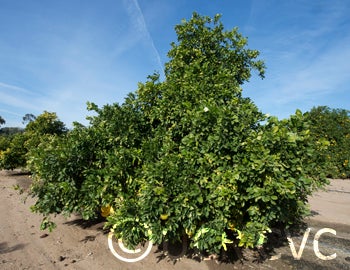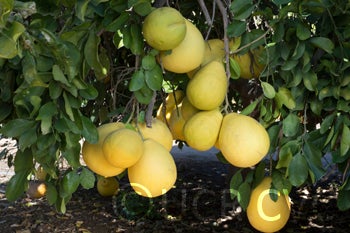Citrus maxima (Burm.) Merr. RUTACEAE
CRC 3926
PI 539393
VI 446
Source
Received as budwood from Import from Hawaii (Special permit from Sacramento), 1984.
Parentage/origins
Parents unknown.
Rootstocks of accession
Carrizo citrange
Season of ripeness at Riverside
October to November
Notes and observations
Exocortis removed by shoot tip grafting.
Original import had exocortis; removed by shoot tip grafting (STG 225-3, 5).--EMN 1986.
12/14/1989, EMN: C.I. description fits well. Good typical pummelo flavor with nice sugar/acid balance in my opinion. Too dern seedy but what else is new in CRC pummeloland? Maybe in solid blocks it would be less seedy.
Description from The Citrus Industry Vol. 1 (1967)
"Fruit large, broadly pyriform with distinct neck; apex even or slightly depressed; seedy if open-pollinated but otherwise not (Soost, 1964). Lemon-yellow at maturity. Rind medium-thick; surface smooth, glossy; less tightly adherent than Kao Pan. Segments numerous and easily separable; carpellary membranes moderately thick and tough; axis small and solid. Vesicles large, easily separable, and firm but juicy. Flavor good (more acid than Kao Pan). Medium-late in maturity and holds well on tree with retention of quality.
Tree similar to Kao Pan, but somewhat more vigorous and upright.
Groff (1927) reports that Kao Phuang is recognized as one of the two best varieties in Thailand, some persons preferring it to the famous Kao Pan. In California, its flavor is clearly superior. In the collections at the University of California Citrus Research Center, Riverside, one of several clones received under the name Siamese is indistinguishable from Kao Phuang, and is probably identical."
Availability
Commercially available in California through the Citrus Clonal Protection Program. Click here to order budwood.
USDA Germplasm Resources Information Network page for Kao Phuang (CRC 3926)


